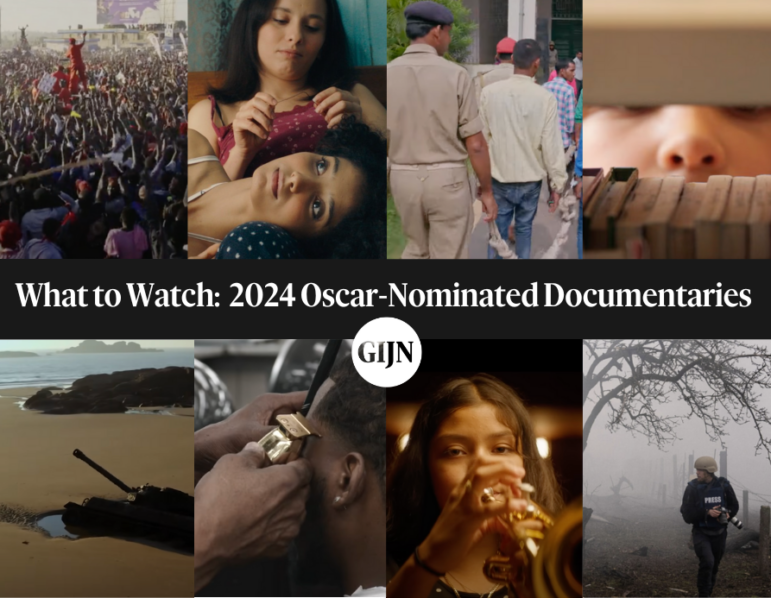

The Future of High-Quality Documentaries Reaching A World Audience
The other day I watched the documentary “The Long Night” on my Mac. For $4.99, MediaStorm served it to me on its website. It was a 70-minute cinematic experience with compelling storytelling, a major current affairs story about minors who are forced into sex trafficking in the United States. A model that may be the future of quality documentary consumption for films not primarily available through the mega streaming platforms.

Set in Seattle, Washington, “The Long Night” by Tim Matsui and MediaStorm weaves together the story of seven people whose lives have been forever changed by the crises of minors who are coerced into the American sex trade.
Coming to Stanford for my JSK Fellowship I wanted to explore ways to improve financing, organization, collaboration and production of high quality documentaries intended for a world audience. The most striking finding so far (and maybe not so surprising) is how the Silicon Valley tech giants are changing the playing field in dramatic ways.
I had not heard about MediaStorm, but after listening to the founder and innovator Brian Storm talking about his company in a Brown Institute for Media Innovation class at Stanford, I spoke with him and had to check out the site. Storm has monetized a service he says is driven by purpose, not profit, so far resulting in 17 Emmy nominations and numerous journalism awards.
Although anyone can publish a film on the net, what MediaStorm has done is noteworthy: They produce the films they offer and are not buying rights for distribution only. Storm is also licensing the technology he has built into his platform. MediaStorm’s film library is small, but steadily expanding and by getting the customers to register on its site, the company is in control of the big data that is so vital to knowing your customers. An annual subscription with access to the entire collection will cost you $23.95. Its content is also available on many other platforms, through various arrangements.
Although MediaStorm is a small operation at this point, and very few players in the industry want to talk in detail about their commercial models or viewership profiles, video is exploding everywhere. It is led by the Silicon Valley behemoths‘ bid to be the providers of all content. Documentary films can be a hard sell and haven’t always enraptured audiences, as duly noted in a recent Vogue article listing the 61 best documentaries of all times. (The list is very U.S.-centric, but has some great recommendations.)
Vogue also concludes that in recent years documentaries have risen to the top of the heap. No wonder, given the amazing breadth of quality films reaching an ever-growing audience. But the potential is even greater, and the importance of providing the public with truthful in-depth information has hardly been more urgent.
Thousands of documentary films are now available through competing specialty streaming and video on demand (VOD) services such as DOX, IndieFlix and CuriosityStream based on pay per view or subscription. The game-changer actors, however, are located in California. In the third quarter of 2017 Netflix globally passed 109 million subscribers and is predicted to pass 160 million in three years. Netflix alone has surpassed the total number of cable subscribers in the U.S. With traditional broadcast TV steadily losing ground everywhere and cord-cutters ending cable subscriptions in droves.
The streaming arena is the new battleground, and Netflix is challenged by Amazon Prime, Hulu, Apple, Facebook and Google (including its subsidiary YouTube). With established players like HBO these platforms are investing more than $10 billion this year in original content (producing themselves and commissioning) in a very crowded market.
Most of this content is entertainment, sports and feature films, but the good news is that this evolution is driving the demand for high-quality documentaries around the world to new heights. Netflix has had great success with its documentaries since launching the “Making a Murderer” series in 2015.
Other providers among the legendary media such as the New York Times and new and ambitious players like Vice, BuzzFeed and Vox are making headway with video and documentaries, as well, particularly courting the Millennials. All of these players are providing access to documentaries we previously would have had major trouble watching anywhere.
Public broadcasters around the world used to be able to pick and choose what documentaries to commission, paying very moderate sums. Prior to the Sundance festival in 2016 a coalition of primarily European public broadcasters had to pool its resources to acquire and co-produce a few high-profile documentaries that otherwise might have been swallowed by the giant digital platforms. Their first acquisition was Nan Fu Wang´s “Hooligan Sparrow,” a bold and important expose of the fight for justice for sexually assaulted schoolgirls in China.
My Nordic colleague, commissioning editor Axel Arnø in Swedish Public Television (SVT), says the coalition can “accommodate festival runs, guarantee good exposure and can help create real impact, but sometimes this is not enough. For new films with all rights available, we realized that we don’t have a chance to bid against Netflix and company. At least, not as individual broadcasters.” Arnø, a veteran chair of the TV Documentary Experts Group in the European Broadcasting Union, says the public broadcasters must continue the dialogue with filmmakers and producers, and might have to make bigger investments in order to secure the most important films.

Launching “An Inconvenient Sequel: Truth to Power” at the Cannes Film Festival, May 2017. Al Gore, Jeff Skoll and other key people from Participant Media.
I recently met with The Hollywood-based production company Participant Media, founded in 2004 by Jeff Skoll. The company is dedicated to entertainment that inspires and compels social change. It is famous for producing and co-producing major documentary films with strong impact. Examples are the Oscar-winning films “An Inconvenient Truth” with Al Gore warning about climate change, and “Citizenfour”, about the sensational NSA leaks by Edward Snowden.
Participant Media had big ambitions and invested heavily in its cable TV channel Pivot, primarily dedicated to documentaries. It was launched in 2013 after Participant acquired the Documentary channel and Halogen TV. But the streaming realities caught up with it: Pivot folded in 2016 after reports of disappointing commercial results and small audiences.
The market for theatrical release of documentary films seems to have come to a halt in light of the huge documentary output now available for streaming. Still, Participant will continue to produce several highly profiled documentaries a year, and has just released the migration doc “Human Flow” for theatrical release in partnership with Amazon Studios and Magnolia Pictures. This film has been shortlisted for an Oscar, together with Participant’s recent follow up “An Inconvenient Sequel: Truth to power.”
Obtaining viable distribution deals with the top-notch documentary makers has gotten a lot more competitive, and a big investment from a streaming giant for worldwide rights may be very tempting for independent producers. Amazon´s willingness to pay in excess of $6 million in January this year for the four-hour documentary “The Long Strange Trip” about the band The Grateful Dead, raised eyebrows and underlined the reshaping of the independent documentary filmmaking ecosystem.
Releases for the big screen around the world is still the goal for many filmmakers, and so is festival circuit exposure. There are non-exclusive rights deals to be made that combine TV, VOD, theatrical release and festivals for specified time windows, involving both distributors and sales agents.
For most independent documentary makers, however, a prestigious deal with a company like Netflix or Participant Media is not a likely scenario. They are lucky if some festivals, broadcasters or philanthropic non-profit institutions show interest in their projects, and their income from a streaming deal could at best be meager.
Two years ago, CEO Andy Taylor of Little Dot Studios in London launched the documentary channel Real Stories on YouTube catering to young audiences.

Real Stories was established on YouTube in 2015 and has grown quickly, now running at over 700,000 daily views. The company has commissioned 11 original documentaries attracting new talent, all now in production.
Speaking at the World Congress of Science and Factual Producers in San Francisco in December, Taylor said he has succeeded in licensing more than 1,000 documentaries, has more than one million subscribers and now also is commissioning new productions and operating on Facebook. But while he characterized this as a major success, a million views on a particular film on his channel only leaves the producer $4,000 to $5,000 in revenue on a 50/50 sharing deal.
If the combined pay-per-view/subscription model of companies like MediaStorm and Real Stories continues to develop, it could pave the way for a wide supply of independent documentary films that reach a worldwide audience without having to rely on the big platforms. When the world around us is spinning, there is simply a need for in-depth treatment to grapple with the confusing and fragmented news flow of the day. Great documentaries provide insight and guidance to the vital issues we care about as citizens, not only as consumers, and have a level of impact that hardly any competing medium has. This has been demonstrated by by the experience of Participant Media and confirmed in independent reports. (AR and VR are exciting and emerging technologies, but their role, growth and effect are still unclear).
Although it seems unavoidable that the tech giants will continue to exercise global dominance, it is also encouraging to see that earlier predictions of a dim future for long-form video and documentary in the era of of snaps, tweets and Facebook posts simply have proven wrong. This is particularly true for the millennial generation. As for the emerging business models, it is still too early to tell if the smaller players will succeed and if the producers can make a living working with them.
I am continuing to explore these models and the questions around them during my fellowship, as well as how new philanthropic sources may support and foster collaboration across borders to encourage production of high quality, current affairs documentary film.
This post first appeared Morten M. Warmedal’s Medium page and is cross-posted here with permission.
 Morten M. Warmedal is a John.S. Knight Journalism Fellow at Stanford University. He’s worked at the Norwegian Broadcasting Corp. since 2003 as executive producer and editor of its flagship weekly investigative program, and as producer and director of documentary series.
Morten M. Warmedal is a John.S. Knight Journalism Fellow at Stanford University. He’s worked at the Norwegian Broadcasting Corp. since 2003 as executive producer and editor of its flagship weekly investigative program, and as producer and director of documentary series.











